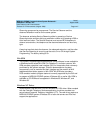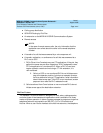
MERLIN LEGEND Communications System Release 6.1
Installation
555-661-140
Issue 1
August 1998
Prior Releases Features and Enhancements
Page xxxii
Release 6.0 Enhancements (February, 1998)
Queue Control
The system manager can control the maximum number of calls allowed in the
primary calling group queue for calls that arrive on certain facilities often
assigned to calling groups. When the number of calls in queue reaches the
programmed maximum, subsequent callers receive a busy signal.
Queue control applies to calls received on the following types of facilities:
■ DID (Direct Inward Dialing)
■ PRI facilities programmed for dial-plan routing
■ All calls transferred from a VMI (voice messaging interface) port
■ Dial-in Tie
Queue control also applies to internal calls to a Calling group and calls to a
calling group through the QCC.
Internal calls that dial a Listed Directory Number (LDN) or and are
directed to a calling group administered as Position-Busy Backup are eligible for
queue control. Calls that come in on a trunk assigned to the Queued Call
Console (QCC) are not eligible for queue control if the call is directed to a calling
group designated as Position-Busy Backup.
Remote-access calls to a calling group, coverage calls directed to a calling
group, calls directed to calling group through QCC Position-Busy backup, and
all other outside calls are not eligible for queue control.
Prompt-Based Overflow
System managers can activate the Prompt-Based Overflow option. This option
allows callers waiting in queue and listening to a delay announcement to press
the # key in order to reach the overflow receiver for the group, which may be the
QCC queue or another calling group (including a calling group assigned for a
voice mail system).
All three overflow distribution options—based on the number of calls, the time a
caller has waited, and according to the caller’s prompt—may be used at one


















